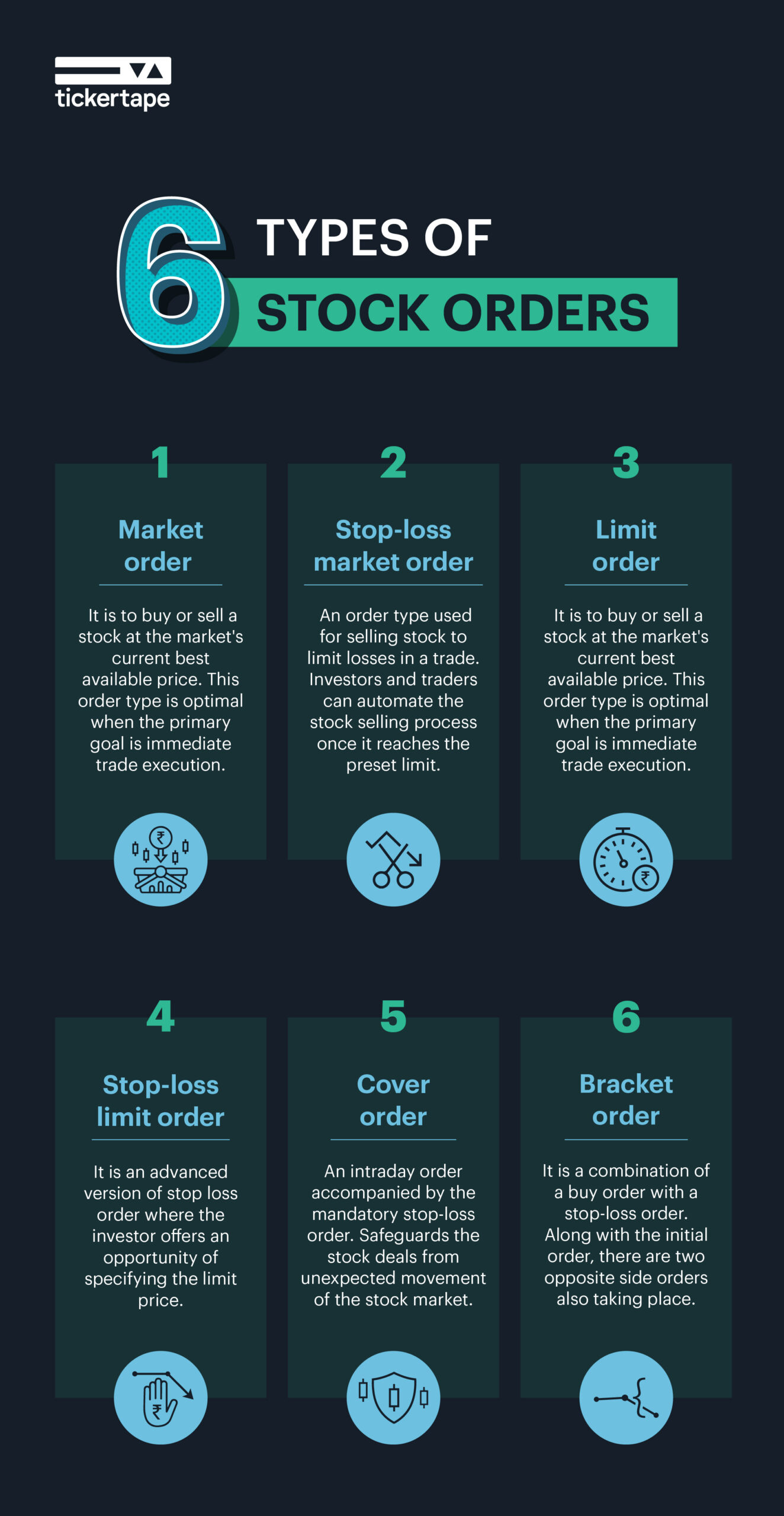Last Updated on Feb 3, 2022 by Ayushi Mishra
The internet has democratised the stock market. People can buy and sell their stocks, monitor their investments, plan their investments just with a click of a button. Any investment plan is pointless unless it is executed by placing an order. An order is basically an instruction that an investor gives to buy or sell stocks over the trading platform. Anyone having a Demat and trading account can place a purchase or sell order over the trading terminal.
Whenever you plan to buy stock in the market, you must place an order with the broker. There are different types of orders in the stock market that support both investing and trading platforms. Here we have discussed the major types of orders in the stock market.
The article covers:
Table of Contents
Market order
It is the most common type of stock market order. It is available at the lowest price, which is the best available in the marketplace. You might observe a minimum difference in the price offered and the price it is being sold. The price that appears on the screen is the price mentioned in the last market transaction of the same stock.
Example
‘A’ purchases a market order stock for five shares of a company at the lowest offer price. But ‘A’ sells off five shares at the highest bid price available in the stock market. Evaluating the book order, if we are placing a market order for buying 5,000 shares, it will match the price with the lowest offer. As per the market order, the first 4,500 shares were purchased for Rs. 998, and the next 500 shares would be purchased for Rs. 999.
Stop-loss market order
It is a kind of advance order issued by the investors and traders for selling a stock. It is used to limit the gains or losses in a trade. When you place a stop-loss market order, investors and traders can automate the stock selling process once it reaches the preset limit. After the breaching of a set price, it becomes a market order. When you place a stop-loss market order, the selling or market price may differ according to the market fluctuations. The best part about the stop-loss market order is that the investor does not have to monitor the day-to-day stock market price.

Limit order
Under this stock market order, the broker and traders are instructed to do the stock trading at the highest price available in the market. This order works only where the stock is equal to or better than the limit price of the stock. It is a kind of order that can be bought during high volatilities to control the price of stocks.
For buy orders: Limit Price < Current Market price, Trade price <= Limit price
For sell orders: Limit Price > Current Market price, Trade price >= Limit price
Example
If the trader placed an order to buy the shares at Rs. 100, the shares will be purchased at Rs. 100 or lower.
Stop-loss limit order
It is the advanced version of the stop-loss market where the trader includes the uncertainties also attached with the stop-loss market order. Under this order, the investor offers an opportunity of specifying the limit price. The stop-loss limit buy order becomes active when the market price of the stock reaches the desired limit.
Example
A trader is purchasing buy order where,
The share price is Rs. 500
Stop loss is Rs. 498
Now the investor is expecting that the share price gets increased so that the deal becomes profitable. If the share price goes less than Rs. 500. Then the trader has to book a loss of Rs. 2 per share and take an exit from the deal. If a trader instructs stop-loss, then the loss would be booked Rs. 5 per share, which is more than the above-discussed scenario.
Cover order
It is an intraday order accompanied by the mandatory stop-loss order. It helps the trader in minimizing the stop-loss order by safeguarding the stock deals from unexpected movement of the stock market. It offers high power and is available mainly in two forms: equity F&O segment and equity cash. There are mainly two orders in cover order- one is a stop-loss order, and the other is a market order. These orders can be sold in short orders and bought long. One of the main benefits of a cover order is that traders can place a stock market order with a stop loss. It minimizes the risk of a substantial amount of capital. The compulsory stop loss feature makes the cover order a better choice in comparison to naked intraday stock orders.
Bracket order
It is another type of stock market order where you get the flexibility to do intraday trading. It is a combination of a buy order with a stop-loss order. Under this, along with the initial order, there are two opposite side orders also taking place. The bracket order works in both scenarios when you are buying the shares and when you are selling the shares.
For instance, when the investor is placing a stock limit order for purchasing a stock of a company that is selling a share for Rs. 1,000 per share. Its stop-loss price is Rs. 970 per share, and the target order is Rs. 1,030 per share. Here the trader sets a bracket price that is Rs. 1,000. It helps in minimizing the risk to some extent.
Understanding the various types of stock order and their working is a must to get a true picture of how the stock market ecosystem works. The investor, as per their comfort and understanding, can go with cover order, bracket order, market order, and stop-loss order.




